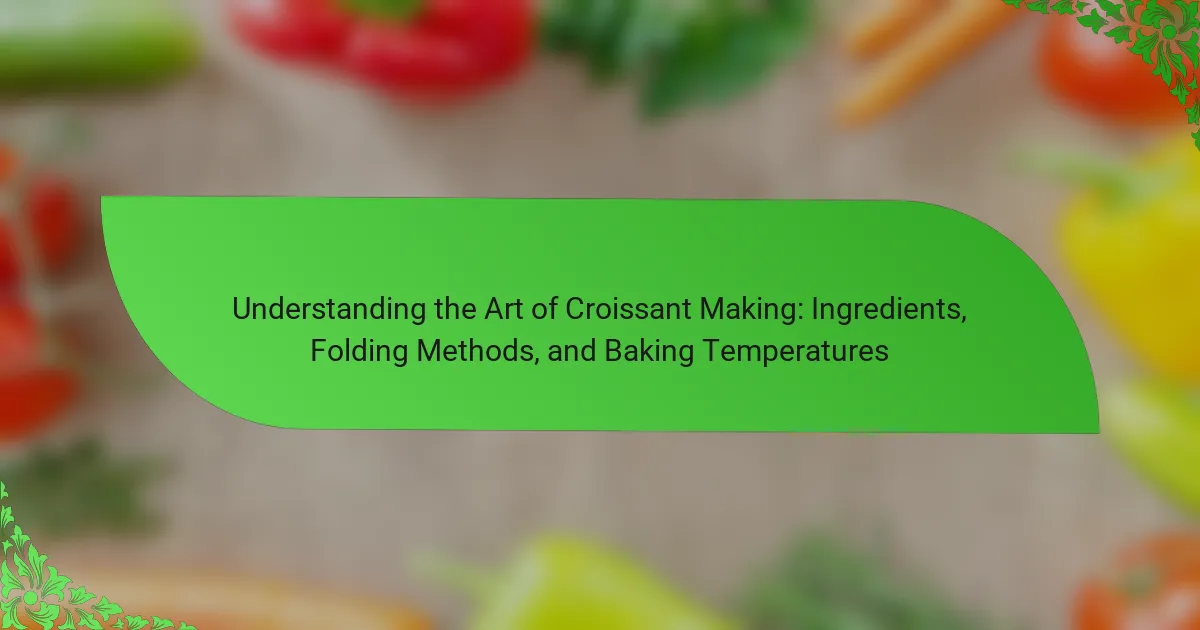Croissants are a popular pastry characterized by their flaky texture and rich flavor, achieved through a specific combination of ingredients and techniques. The essential ingredients for croissant making include flour, water, yeast, salt, sugar, and butter, each playing a vital role in the dough’s structure and taste. Key folding methods, such as the book fold and letter fold, are crucial for creating the layers that define croissants. Additionally, baking temperatures between 375°F and 400°F are important for achieving a golden-brown crust while maintaining a tender interior. This article provides an overview of the ingredients, folding techniques, and baking temperatures necessary for mastering the art of croissant making.

What are the essential ingredients for making croissants?
The essential ingredients for making croissants are flour, water, yeast, salt, sugar, and butter. All-purpose flour provides the necessary structure and gluten. Water hydrates the dough and activates the yeast. Yeast is crucial for fermentation and leavening. Salt enhances flavor and controls yeast activity. Sugar adds sweetness and aids in browning. Butter is key for creating the flaky layers through lamination. These ingredients combine to create the distinctive texture and taste of croissants.
How do different types of flour affect croissant texture?
Different types of flour significantly affect croissant texture. All-purpose flour provides a balanced structure but may yield a less flaky croissant. Bread flour, with higher protein content, promotes gluten development, resulting in a chewier texture. Pastry flour, being lower in protein, creates a tender, delicate crumb. The choice of flour influences the layers and overall flakiness of the croissant. High-protein flours create more layers due to better gluten formation during lamination. In contrast, lower-protein flours can lead to a denser product. Therefore, selecting the right flour is crucial for achieving desired croissant characteristics.
What is the role of butter in croissant making?
Butter is essential in croissant making for flavor, texture, and flakiness. It contributes to the rich taste that characterizes croissants. The fat in butter creates layers during the lamination process. This layering is crucial for achieving the desired flaky structure. When baked, the water in butter generates steam. This steam helps the layers separate, resulting in a light and airy pastry. Additionally, butter enhances the overall mouthfeel of the croissant. High-quality butter is often preferred for its flavor and melting properties.
How does yeast contribute to croissant rise?
Yeast contributes to croissant rise by producing carbon dioxide during fermentation. This gas forms bubbles in the dough, creating a light and airy texture. As the dough is kneaded and folded, yeast activity increases. The fermentation process typically takes several hours, allowing for optimal gas production. Additionally, yeast enhances flavor through its byproducts. The combination of gas expansion and flavor development is crucial for the final croissant quality.
What other ingredients are important in croissant recipes?
Flour, yeast, salt, and sugar are important ingredients in croissant recipes. All-purpose or bread flour provides the necessary gluten structure. Yeast is essential for leavening, creating the croissant’s airy texture. Salt enhances flavor and controls yeast fermentation. Sugar contributes to browning and adds a slight sweetness. Additionally, milk or water is often included to hydrate the dough. Each ingredient plays a crucial role in achieving the desired taste and texture of croissants.
How do sugar and salt influence flavor and fermentation?
Sugar enhances sweetness and balances flavors in croissant dough. It also promotes fermentation by feeding yeast. Yeast converts sugar into carbon dioxide and alcohol. This process improves dough rise and texture. Salt, on the other hand, regulates yeast activity. It strengthens gluten structure in the dough. This results in better texture and flavor development. Salt also enhances overall taste by balancing sweetness. The interplay of sugar and salt is crucial for optimal fermentation and flavor in croissant making.
What is the significance of water temperature in dough preparation?
Water temperature is crucial in dough preparation as it affects yeast activity and gluten development. Warm water activates yeast more quickly, promoting fermentation. This results in a lighter and airier dough. Conversely, cold water slows fermentation, leading to a denser texture. The ideal water temperature for croissant dough is typically around 75°F to 80°F. This range optimizes yeast performance while allowing for proper gluten formation. Maintaining the right temperature ensures a balanced rise and texture in the final product.

What are the key folding methods in croissant making?
The key folding methods in croissant making are the book fold and the letter fold. The book fold involves folding the dough into thirds, resembling a book. This method creates layers by trapping butter between the dough. The letter fold is similar but involves folding the dough into thirds, then folding that in half again. Both methods are essential for achieving the flaky texture of croissants. These techniques are critical in lamination, which is the process of incorporating butter into the dough. Proper execution of these folds ensures even distribution of butter and creates the desired layers.
How does the lamination process work?
The lamination process involves layering dough and butter to create flaky pastry. First, a dough is prepared, usually containing flour, water, yeast, and salt. Then, a block of cold butter is encased within the dough. This dough is rolled out and folded multiple times, creating layers. Each fold traps air and creates distinct layers of butter and dough. The process is repeated several times, typically three to six folds. This technique results in a light, airy texture when baked. The science behind lamination relies on steam generated during baking, which causes the layers to separate and puff up.
What are the steps involved in creating layers?
The steps involved in creating layers in croissant making include preparing the dough, incorporating butter, and performing folds. First, mix flour, water, yeast, and salt to form the base dough. Next, roll out cold butter into a flat sheet. Place the butter sheet in the center of the dough and fold the dough over it. Seal the edges to encase the butter completely. Roll the dough into a rectangle and perform a series of folds, typically three single folds or one double fold. Each fold creates distinct layers of dough and butter. Finally, refrigerate the dough between folds to maintain the butter’s firmness. This process results in the flaky texture characteristic of croissants.
How does folding technique impact the final product?
Folding technique significantly impacts the final product of croissants. It determines the layers of dough and butter, crucial for flakiness. Proper folding creates distinct layers, allowing steam to separate them during baking. This results in a light, airy texture. Insufficient folding can lead to dense, heavy croissants. The number of folds also influences the final product’s rise and overall structure. For instance, a traditional three-fold method enhances the lamination process. Research shows that precise folding techniques can increase the volume of baked goods by up to 30%. Therefore, mastering folding is essential for achieving the desired quality in croissant making.
What are common folding methods used by bakers?
Common folding methods used by bakers include the letter fold, book fold, and tri-fold. The letter fold involves folding the dough into thirds, resembling a letter. This method helps create layers in the dough. The book fold is similar but involves folding the dough in half and then folding each half into the center. This technique increases the number of layers further. The tri-fold method consists of folding the dough into thirds, similar to the letter fold but can vary in thickness. Each of these methods contributes to the flakiness and texture of baked goods, particularly in pastries like croissants.
What is the difference between single and double folds?
Single folds involve folding the dough in thirds, creating three layers. This method is simpler and quicker, typically used in the initial stages of lamination. Double folds consist of folding the dough in thirds twice, resulting in more layers. This technique creates a flakier texture and is often employed after a few single folds. The difference lies in the number of layers produced. Single folds create fewer layers than double folds, enhancing the croissant’s structure and flakiness.
How do variations in folding affect croissant flakiness?
Variations in folding significantly affect croissant flakiness. The folding technique determines the number of layers created in the dough. More folds lead to more layers, resulting in increased flakiness. Each layer traps steam during baking, which contributes to the light, airy texture. For instance, a traditional three-fold method creates fewer layers than a book fold. Research indicates that a book fold can yield up to 81 layers. This increase in layers enhances the croissant’s overall flakiness and texture. Therefore, the choice of folding method directly influences the final product’s quality.

What baking temperatures are recommended for croissants?
Croissants are typically baked at temperatures ranging from 375°F to 400°F (190°C to 200°C). This temperature range ensures a golden-brown crust while allowing the interior to remain flaky and tender. Baking at 375°F provides a slower bake, which can enhance the texture. Conversely, baking at 400°F results in a quicker bake, producing a crispier exterior. Many professional bakers recommend preheating the oven to ensure even baking. Proper oven temperature is crucial for achieving the desired rise and flakiness in croissants.
How does temperature influence croissant baking?
Temperature significantly influences croissant baking by affecting dough fermentation, lamination, and final texture. Higher temperatures accelerate yeast activity during fermentation. This leads to quicker rising and can result in a lighter croissant. However, excessive heat can cause the butter to melt too quickly, compromising the layers.
Conversely, lower temperatures slow down fermentation. This allows for a more controlled rise and can enhance flavor development over time. Baking temperature also plays a crucial role. Typically, croissants are baked at 375°F to 400°F. This range ensures a golden-brown exterior while maintaining a soft, airy interior.
Inadequate temperature control can lead to uneven baking. For instance, insufficient heat can result in a doughy texture, while too much heat can burn the outer layers before the inside cooks thoroughly. Thus, maintaining optimal temperature is essential for achieving the desired croissant characteristics.
What is the ideal oven temperature for baking croissants?
The ideal oven temperature for baking croissants is 375°F (190°C). This temperature allows for a balanced rise and browning. At 375°F, the outer layers become crispy while the inside remains flaky. Baking at this temperature ensures even cooking throughout the croissant. Many professional bakers recommend this temperature for optimal results. It is crucial to preheat the oven to achieve consistent baking. Proper preheating helps to create steam, which is essential for the croissant’s texture.
How does preheating affect the baking process?
Preheating ensures that the oven reaches the desired temperature before baking begins. This step is crucial for achieving optimal rise and texture in baked goods. When the oven is preheated, the heat is evenly distributed, allowing for consistent baking. For croissants, preheating helps activate the yeast, leading to better leavening. It also creates a crisp outer layer while keeping the inside flaky. Studies show that baking at the correct temperature improves the final product’s quality. For instance, a preheated oven can reduce baking time and enhance browning. This results in a more appealing appearance and improved flavor.
What are the signs of properly baked croissants?
Properly baked croissants have a golden-brown exterior. This color indicates even baking and caramelization of sugars. The texture should be flaky and crisp on the outside. A well-baked croissant will have a light, airy interior. This is achieved through proper lamination of the dough. The croissant should also have a pronounced rise. This rise results from steam created during baking. Finally, a properly baked croissant emits a rich, buttery aroma. This aroma signals the use of quality ingredients and correct baking techniques.
How can you tell when croissants are done baking?
Croissants are done baking when they are golden brown and have a crispy exterior. The internal temperature should reach about 190°F to 200°F. A visual check shows a uniform color without any pale spots. Tapping the bottom of a croissant should produce a hollow sound. These indicators confirm that the dough has cooked through properly. The Maillard reaction contributes to the desired color and flavor. Croissants typically take 15 to 20 minutes at 375°F to achieve this doneness.
What are common mistakes to avoid during baking?
Common mistakes to avoid during baking include not measuring ingredients accurately. Accurate measurements are crucial for achieving the desired texture and flavor. Another mistake is not preheating the oven. Preheating ensures even baking and proper rising. Additionally, opening the oven door too often can disrupt temperature stability. This can lead to uneven baking results. Using expired ingredients is also a common error. Fresh ingredients are essential for optimal flavor and performance. Lastly, neglecting to follow the recipe precisely can result in failure. Each step in a recipe is designed for a specific outcome.
What tips can enhance your croissant making skills?
Use high-quality ingredients for better flavor and texture. Choose European-style butter with at least 82% fat content. This butter creates a flakier croissant. Maintain proper dough temperature throughout the process. Keeping the dough cool prevents overworking the gluten. Follow precise measurements for flour and water. Accurate ratios ensure consistent results. Use a rolling pin to create even layers. This technique helps achieve the desired lamination. Allow adequate resting time for the dough. Resting relaxes the gluten and improves elasticity. Preheat the oven to the correct temperature before baking. A hot oven promotes proper rising and browning. Monitor baking time closely for optimal results. Adjust based on the size of your croissants.
The main entity of this article is croissant making, which encompasses essential ingredients, folding methods, and baking temperatures. Key ingredients include flour, water, yeast, salt, sugar, and butter, each playing a vital role in achieving the desired texture and flavor. The article explores how different types of flour affect croissant texture, the significance of butter and yeast in the process, and the importance of precise folding techniques for creating layers. Additionally, it outlines recommended baking temperatures and common mistakes to avoid, providing practical tips to enhance croissant-making skills.
